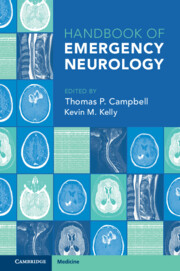Book contents
- Handbook of Emergency Neurology
- Handbook of Emergency Neurology
- Copyright page
- Contents
- Contributors
- Section 1 Neurologic Examination and Neurodiagnostic Testing
- Section 2 Common Neurologic Presentations: A Symptom-Based Approach
- Section 3 Specific Neurological Disorders in Emergency Medicine
- Chapter 11 Ischemic Stroke and Transient Ischemic Attack
- Chapter 12 Intracranial Hemorrhage
- Chapter 13 Seizures
- Chapter 14 Infections of the Central Nervous System
- Chapter 15 Traumatic Brain Injury
- Chapter 16 Increased Intracranial Pressure and Herniation Syndromes
- Chapter 17 Traumatic and Nontraumatic Spinal Cord Disorders
- Chapter 18 Neuro-ophthalmology Emergencies
- Chapter 19 Brain Tumors and Other Neuro-oncologic Emergencies
- Chapter 20 Peripheral Nerve and Neuromuscular Disorders
- Chapter 21 Movement Disorders
- Chapter 22 Multiple Sclerosis
- Chapter 23 Hydrocephalus and Shunt Evaluation
- Chapter 24 Post-Arrest Neurologic Resuscitation
- Chapter 25 Neurotoxicology
- Chapter 26 Neurologic Emergencies of Pregnancy
- Chapter 27 Brain Death
- Chapter 28 Hysteria
- Index
- References
Chapter 23 - Hydrocephalus and Shunt Evaluation
from Section 3 - Specific Neurological Disorders in Emergency Medicine
Published online by Cambridge University Press: 10 January 2024
- Handbook of Emergency Neurology
- Handbook of Emergency Neurology
- Copyright page
- Contents
- Contributors
- Section 1 Neurologic Examination and Neurodiagnostic Testing
- Section 2 Common Neurologic Presentations: A Symptom-Based Approach
- Section 3 Specific Neurological Disorders in Emergency Medicine
- Chapter 11 Ischemic Stroke and Transient Ischemic Attack
- Chapter 12 Intracranial Hemorrhage
- Chapter 13 Seizures
- Chapter 14 Infections of the Central Nervous System
- Chapter 15 Traumatic Brain Injury
- Chapter 16 Increased Intracranial Pressure and Herniation Syndromes
- Chapter 17 Traumatic and Nontraumatic Spinal Cord Disorders
- Chapter 18 Neuro-ophthalmology Emergencies
- Chapter 19 Brain Tumors and Other Neuro-oncologic Emergencies
- Chapter 20 Peripheral Nerve and Neuromuscular Disorders
- Chapter 21 Movement Disorders
- Chapter 22 Multiple Sclerosis
- Chapter 23 Hydrocephalus and Shunt Evaluation
- Chapter 24 Post-Arrest Neurologic Resuscitation
- Chapter 25 Neurotoxicology
- Chapter 26 Neurologic Emergencies of Pregnancy
- Chapter 27 Brain Death
- Chapter 28 Hysteria
- Index
- References
Summary
Hydrocephalus is an extremely common neurological condition encountered in the emergency department (ED). The condition is characterized by symptomatic inability to drain or resorb CSF, resulting in pressure build-up within the brain. Hydrocephalus can result from both congenital and acquired etiologies, many of which can respond to shunting. The symptoms of hydrocephalus are classically due to an increase in intracranial pressure (ICP); however, normal- or low-pressure variants can occur. Hydrocephalus can result from a blockage within the ventricular system (“obstructive”) or outside the ventricular system (“communicating”), thereby impairing CSF absorption into the cerebral venous sinuses. Hydrocephalus may also be caused by failure of CSF to be absorbed secondary to abnormalities in the brain parenchyma itself.
Keywords
- Type
- Chapter
- Information
- Handbook of Emergency Neurology , pp. 334 - 345Publisher: Cambridge University PressPrint publication year: 2023

